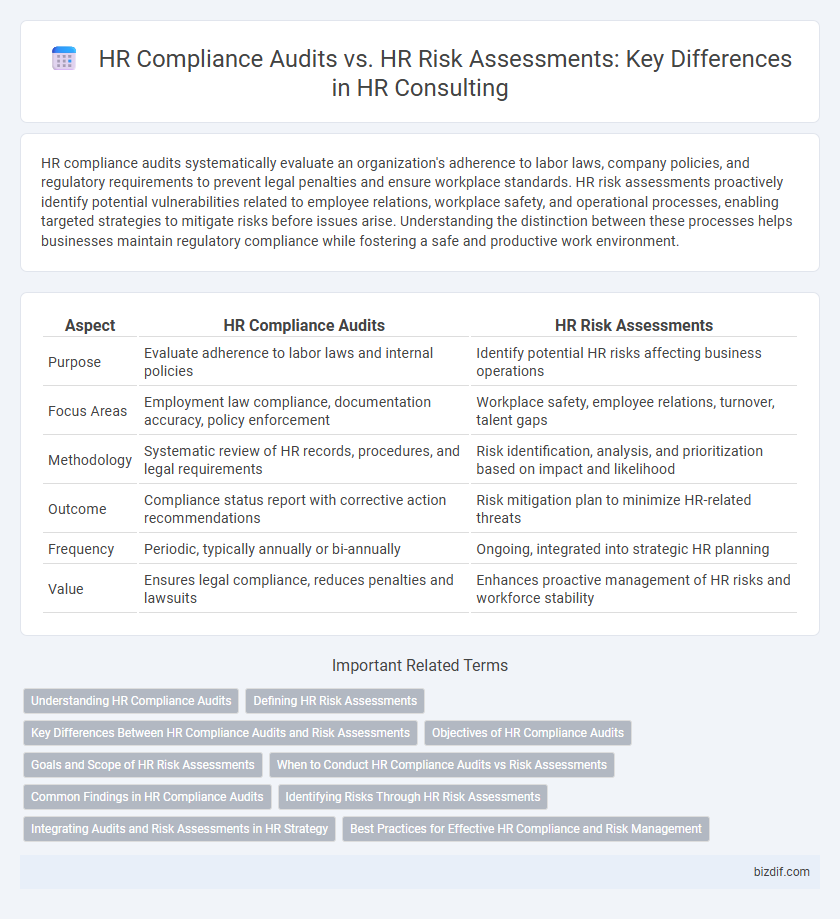HR compliance audits systematically evaluate an organization's adherence to labor laws, company policies, and regulatory requirements to prevent legal penalties and ensure workplace standards. HR risk assessments proactively identify potential vulnerabilities related to employee relations, workplace safety, and operational processes, enabling targeted strategies to mitigate risks before issues arise. Understanding the distinction between these processes helps businesses maintain regulatory compliance while fostering a safe and productive work environment.
Table of Comparison
| Aspect | HR Compliance Audits | HR Risk Assessments |
|---|---|---|
| Purpose | Evaluate adherence to labor laws and internal policies | Identify potential HR risks affecting business operations |
| Focus Areas | Employment law compliance, documentation accuracy, policy enforcement | Workplace safety, employee relations, turnover, talent gaps |
| Methodology | Systematic review of HR records, procedures, and legal requirements | Risk identification, analysis, and prioritization based on impact and likelihood |
| Outcome | Compliance status report with corrective action recommendations | Risk mitigation plan to minimize HR-related threats |
| Frequency | Periodic, typically annually or bi-annually | Ongoing, integrated into strategic HR planning |
| Value | Ensures legal compliance, reduces penalties and lawsuits | Enhances proactive management of HR risks and workforce stability |
Understanding HR Compliance Audits
HR compliance audits systematically evaluate an organization's adherence to labor laws, employment regulations, and internal policies, ensuring all HR practices meet legal and industry standards. These audits typically involve reviewing documentation such as employee files, payroll records, and workplace policies to identify non-compliance issues and potential legal liabilities. By conducting HR compliance audits, companies can proactively address regulatory gaps, reduce the risk of costly penalties, and maintain a fair and legally compliant workplace environment.
Defining HR Risk Assessments
HR Risk Assessments involve a proactive evaluation of potential vulnerabilities within an organization's human resources policies, procedures, and practices to identify and mitigate risks before they materialize. This process examines factors such as regulatory compliance gaps, employee relations issues, and operational inefficiencies that could lead to legal liabilities or financial losses. Unlike HR Compliance Audits, which focus on verifying adherence to existing laws and regulations, HR Risk Assessments prioritize identifying emerging threats and establishing strategic controls to enhance overall organizational resilience.
Key Differences Between HR Compliance Audits and Risk Assessments
HR compliance audits systematically evaluate company adherence to labor laws, regulations, and internal policies to ensure legal conformity and avoid penalties, focusing on documentation and procedural accuracy. In contrast, HR risk assessments identify potential vulnerabilities in workforce management, such as employee relations issues, talent gaps, or health and safety risks, aiming to proactively mitigate operational threats. The key difference lies in audits emphasizing regulatory compliance, while risk assessments prioritize forward-looking risk identification and management strategies.
Objectives of HR Compliance Audits
HR Compliance Audits primarily focus on verifying adherence to labor laws, company policies, and industry regulations to prevent legal penalties and ensure ethical workplace practices. These audits systematically review employment records, payroll processes, workplace safety standards, and employee classification to identify compliance gaps. The objective is to establish a transparent, legally compliant HR framework that minimizes exposure to lawsuits and regulatory fines.
Goals and Scope of HR Risk Assessments
HR Risk Assessments focus on identifying potential threats to workforce stability, employee safety, and regulatory adherence by evaluating policies, procedures, and workplace practices to mitigate risks before they result in violations or harm. The primary goal is to proactively recognize vulnerabilities in areas such as discrimination, harassment, wage and hour laws, and workplace safety, enabling targeted interventions. Unlike compliance audits that verify adherence, HR Risk Assessments emphasize forward-looking risk identification and prevention across an organization's human capital management.
When to Conduct HR Compliance Audits vs Risk Assessments
HR compliance audits should be conducted regularly or when regulatory changes occur to ensure adherence to labor laws and company policies, minimizing legal penalties and maintaining organizational integrity. HR risk assessments are essential during periods of organizational change, such as mergers, expansions, or new technology implementations, to identify potential threats to workforce stability and productivity. Conducting these evaluations at strategic intervals helps mitigate compliance violations and proactively manage risks affecting human capital.
Common Findings in HR Compliance Audits
Common findings in HR compliance audits often include incomplete employee documentation, such as missing I-9 forms or outdated personnel files, and failure to adhere to wage and hour laws, including incorrect overtime calculations. Non-compliance with federal and state employment regulations like FMLA, FLSA, and EEO requirements frequently emerges, highlighting gaps in policy implementation and employee training. These frequent issues reveal significant exposure to legal penalties and emphasize the necessity of regular HR compliance audits to mitigate operational risks.
Identifying Risks Through HR Risk Assessments
HR Risk Assessments identify potential hazards within workforce management by evaluating areas such as employee relations, regulatory adherence, and workplace safety. These assessments analyze data trends and compliance gaps to proactively mitigate issues before they escalate into legal or operational risks. Unlike HR Compliance Audits, which focus on verifying adherence to existing policies, risk assessments prioritize uncovering vulnerabilities that may impact organizational performance and employee well-being.
Integrating Audits and Risk Assessments in HR Strategy
Integrating HR compliance audits and HR risk assessments into the overall HR strategy ensures comprehensive identification and mitigation of potential legal and operational hazards. This combined approach enhances organizational resilience by aligning regulatory adherence with proactive risk management, optimizing workforce policies and procedures. Leveraging data-driven insights from both audits and assessments drives continuous improvement and strategic decision-making in human capital management.
Best Practices for Effective HR Compliance and Risk Management
Conducting HR compliance audits ensures adherence to labor laws, company policies, and regulatory requirements by systematically reviewing documentation and practices. HR risk assessments identify potential vulnerabilities in workforce management, focusing on areas such as employee relations, compensation, and workplace safety to proactively mitigate legal and operational risks. Integrating regular compliance audits with dynamic risk assessments enables organizations to implement best practices, maintain regulatory alignment, and foster a resilient HR framework.
HR Compliance Audits vs HR Risk Assessments Infographic

 bizdif.com
bizdif.com